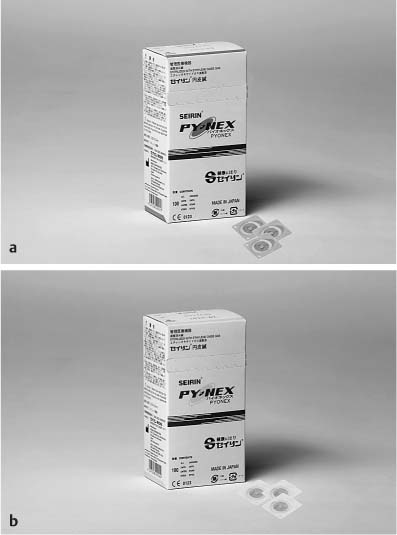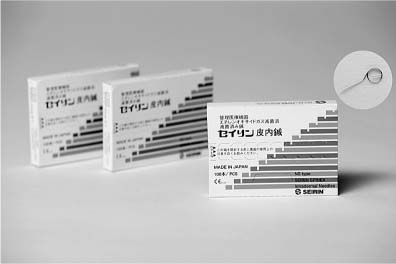12 Dermal Needles and Associated Techniques Press-spheres are used very frequently on children. They are easy and safe to use. The Pyonex press-tack needles are next most commonly used and are relatively easy and safe to use on children. Intradermal needles are generally easy and safe to use on children, but their care and precautions are more than for the other two, and so they tend to be used less frequently. These three tools provide a mild continuous stimulation of the acupoint between visits with you. These are small metal balls that come on a piece of tape ready for placing on the body. There are a number of different brands and types. The most common brands are the “Accu-Patch” or “Magrain.” The Accu-Patch comes in stainless steel, gold plated, and silver plated. The Magrain comes in gold plated, silver plated, copper plated, and zinc plated. The type that you will need will be either the stainless-steel or gold-plated types. To place them, it is better to use tweezers so as not to reduce the stickiness of the tape. The press-tack needles are retained on the acupoint for a number of hours or days. The press-tack needles I recommend are a relatively new design type from Seirin. For children, use the very short 0.3-mm (orange-coded) or 0.6-mm (yellow-coded) and very thin (0.20-mm gauge) needles (Fig. 12.1a, b). The metal needle is embedded into a solid plastic base, placed on tape, and presented in pre-sterilized easy-to-use packaging. They can be administered without the use of tweezers. Fig. 12.1a,b Box of 0.3-mm (a) and 0.6-mm (b) long Pyonex with a few needles on the side. The intra-dermal needles are short needles that are left inserted into the acupoint for a number of hours or days. I recommend the use of the “Spinex” needles from Seirin (Fig. 12.2). For children use the 3-mm-long needles (0.12 mm gauge). They are individually packaged and pre-sterilized. To handle and insert these needles you need to use tweezers. They do not come on a piece of tape and have to be taped separately after they have been inserted. Fig. 12.2 Box of 3-mm Spinex with a needle on the side. In order to use the press-spheres, press-tack needles, and intra-dermal needles to best advantage, we need a good strategy for selecting between them. Here, it is useful to consider the relative dose effects of each instrument. The press-sphere is non-invasive; it applies a light stimulation through soft pressure to the acupoints. The new Pyonex press-tack needles are invasive, inserting a very small amount into the skin (0.3 mm or 0.6 mm), giving a mild stimulation to the acupoints that is greater than the press-sphere and that increases with the increased length of the press-tack needle. The intra-dermal needles are invasive and insert more into the body than the press-tack needles. We usually use 3 mm-long intra-dermal needles for children, which means that the portion of the needle that is inserted into the body is 1–1.5 mm long. Thus, the intra-dermal needles give a slightly higher dose than the press-tack needles.1 We can visualize these three treatment methods in terms of a continuous dose range, where the intra-dermal needle gives the greater dose, the press-tack an intermediate level dose, and the press-sphere the lower dose (see Fig. 12.3). __________________
Ryu—Press-spheres, Empishin—Press-tack Needles, and Hinaishin—Intra-dermal Needles
 Press-spheres
Press-spheres
 Empishin—(Pyonex) Press-tack Needles
Empishin—(Pyonex) Press-tack Needles
 Hinaishin—Intra-dermal Needles
Hinaishin—Intra-dermal Needles
Selecting between Use of Intra-dermal Needles, Press-tack Needles, and Press-spheres
Stay updated, free articles. Join our Telegram channel

Full access? Get Clinical Tree




